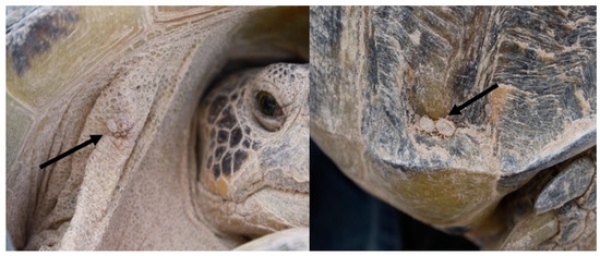Â
The Bolson tortoise (Bolson Gopherus flavomarginatus) is the largest land reptile in North America. It lives mainly in dry areas, in particular, in the Chihuahua desert in northern Mexico. In recent decades, its numbers have fallen by 50%, driving the International Union for Conservation of Nature to include it on its red list and it has been classified as endangered. Land tortoises are prone to suffering from a wide range of diseases that can deplete their numbers even more, therefore understanding potential pathogenic organisms could help in advancing conservation strategies.
This was the task set for a research team made up of members from different universities and Mexican entities, including Zoology Professor Francisco Sánchez Tortosa from the University of Córdoba, given his knowledge and experience in conservation biology. Specifically, in this research study, published in Biology, the bacteria present in Ornithodoros turicata ticks were analyzed. These ticks are parasites on tortoises and can transmit diseases to them.
In order to carry out the research, 45 Bolson tortoises were captured at the Mapimí Biosphere Reserve in Mexico, out of which 11 had ticks on their shell or their skin. 17 adult ticks were collected to analyze the bacteria they carried, by means of next generation sequencing.
In the analyses, a large number of potentially pathogenic bacteria was found. This could be due to the large variety of guests found on these kinds of ticks that act as hosts. These live in the big burrows built by the tortoises and used by other animal species such as rodents, birds and other reptiles, that they are parasites on as well.
Among the most numerous bacteria detected are Proteobacteria, Actinobacteria and Firmicutes. Of these, two documented bacteria were registered as pathogens, Mycoplasma spp and Pasteurella testudinis. In addition, A. marginale pathogenic bovine bacteria and A. kovis pathogenic ovine bacteria were detected, as well as A. phagocytophilum, Coxiella burnetii and Neoehrlichia sp zoonoctic bacteria.
According to Professor Francisco Sánchez Tortosa, these results could be interpreted in two ways. On the one hand, this research could lead us to believe that these ticks, and in turn these tortoises, carry diseases that could spread to other animal species, such as livestock, and ultimately, to humans. "That would be an erroneous and catastrophic interpretation as it could lead to a campaign against it that could end in this species's extinction", he asserts.
On the other hand, his vision is more optimistic. "Jumps from one species to another are very uncommon. Now we have this information, but these pathogens have been living with all the other fauna for thousands of years and nothing has ever happened. If we were to perform this research with other animal species, we would surely find similar results. This research is simply a tool in order for us to better understand natural processes and help conserve this species of tortoise, not the other way around", he explains.
The tortoises with parasites did not show evident signs of disease, so further research is needed to understand the tortoises' defense mechanisms against diseases that can be transmitted by ticks, and their characteristics as guests.
Reference:
Sergio I. Barraza-Guerrero , César A. Meza-Herrera , Cristina García-De la Peña,Vicente H. González-Álvarez , Felipe Vaca-Paniagua, Clara E. Díaz-Velásquez,Francisco Sánchez-Tortosa, Verónica Ávila-Rodríguez, Luis M. Valenzuela-Núñez and Juan C. Herrera-Salazar. General Microbiota of the Soft Tick Ornithodoros turicata Parasitizing the Bolson Tortoise (Gopherus flavomarginatus) in the Mapimi Biosphere Reserve, Mexico. Biology 2020, 9, 275; doi:10.3390/biology9090275


